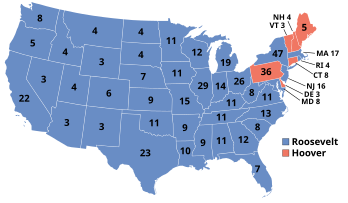United States presidential election, 1932
|
|
|||||||||||||||||||||||||||||||||||||||||||
|
|||||||||||||||||||||||||||||||||||||||||||
|
|||||||||||||||||||||||||||||||||||||||||||
|
|
|||||||||||||||||||||||||||||||||||||||||||
| Presidential election results map. Blue denotes those won by Roosevelt/Garner, red denotes states won by Hoover/Curtis. Numbers indicate the number of electoral votes allotted to each state. | |||||||||||||||||||||||||||||||||||||||||||
|
|||||||||||||||||||||||||||||||||||||||||||
Franklin D. Roosevelt
Democratic
The United States presidential election of 1932 was the thirty-seventh quadrennial presidential election, held on Tuesday, November 8, 1932. The election took place against the backdrop of the Great Depression that ruined the promises of incumbent President and Republican candidate Herbert Hoover to bring about a new era of prosperity. The Democratic nomination went to the well-known governor of the most populous state, New York's Franklin D. Roosevelt, who had been reelected governor in a landslide in 1930. Roosevelt united all wings of his party, avoided divisive cultural issues, and brought in a leading Southern conservative as his running mate, House Speaker John Nance Garner of Texas. While Hoover won the last election by a landslide victory margin of 17.4%, Roosevelt won this election by 17.7%.
Roosevelt repeatedly blamed Hoover for the Depression and worsening economy. With unemployment above 20% in 1932 alone, Hoover was remiss to defend his record, and Roosevelt promised recovery with a New Deal for the American people. Roosevelt won by a landslide in both the electoral and popular vote, receiving the highest percentage of the popular vote for a Democratic nominee. The election marked the effective end of the Fourth Party System, dominated by Republicans. Subsequent landslides in the 1934 mid-term elections and following presidential election two and four years later respectively, signified the commencement of the Fifth Party System, dominated by Roosevelt's New Deal Coalition.
...
Wikipedia




